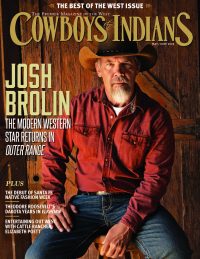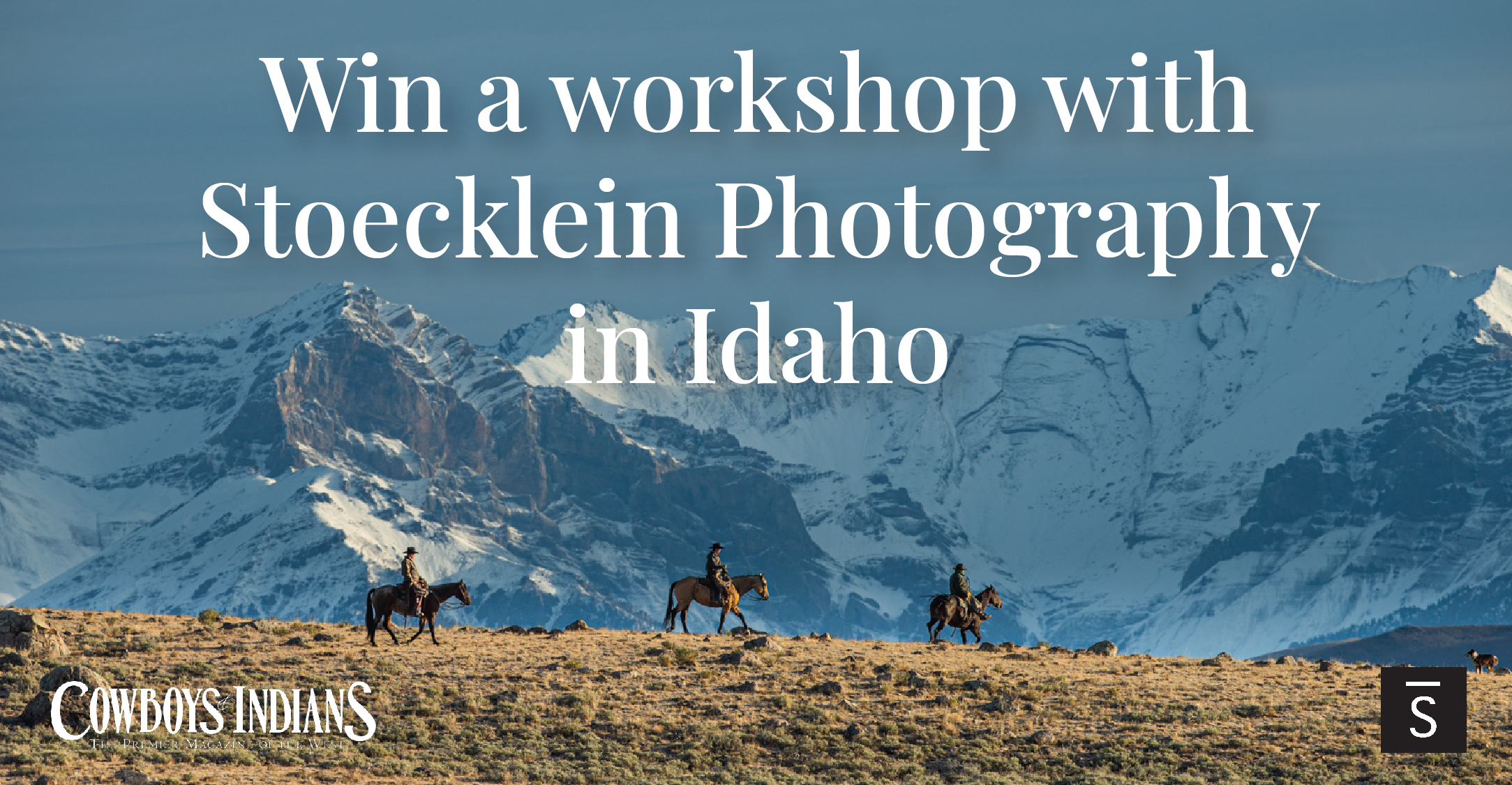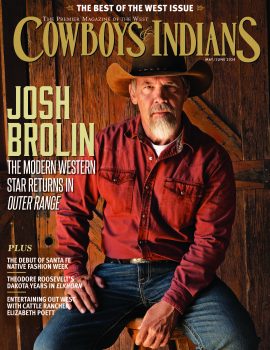Associated with his Montana and California home landscapes, and friends like writer Jim Harrison, this artist and avid outdoorsman wants you to look at his paintings and know he was having a helluva good time.
If the work of a master Western landscape painter is never really done, Russell Chatham has probably gotten closer than anyone. The self-taught artist and inveterate outdoorsman — tapped by Field & Stream as the country’s greatest living landscape painter — has delved into the wild Western canvas with a lifelong passion and tireless sense of purpose and play that can be called legendary without a brushstroke of hyperbole.
“I’ve been painting ever since I was little — and as soon as I was able to drive and got an old beater car, I was a fisherman and a hunter as well,” says the 78-year-old artist and accomplished writer and angler, whose earliest exhibitions in the 1950s drew on the small ranching communities of Northern California’s Marin and Monterey counties where he grew up. Eventually, Chatham would take on the goliath of Western imagery — Montana — where, over a three-decade tenure, his oil paintings and exhaustively detailed lithographs would find fame and sky-high demand among the country’s top art collectors and other big names.
“I really didn’t go there thinking that if I hang out in Montana I’ll be a successful artist. I just pretty much assumed I would never be one in that way,” says Chatham, who isn’t averse to spending a year or more on a painting to get it exactly right in spite of short gallery supplies of his work and long client waiting lists. “That’s not what all of this was ever about anyway. I just wanted to do it — plain and simple.”
Chatham is also naturally complex. His laborious lithographic process has utilized as many as 50 plates and ink shades (standard lithography often sticks to three or four). Although the effect of his art is anything but laborious. Gazing into the paradox of a Chatham oil painting — dreamy and real, rich and spare, warm and shivery, quiet yet intense, joyful yet sometimes foreboding — is less a visual exercise than an absorbing one. These are transportive, experiential images. A cluster of aspens glowing by a hulking hill. A linear horizon of wilderness meeting a shapeless, spectral sweep of approaching rain. A pair of cumulous cloud shapes, grazing like faintly recognizable farm animals in the sky above the oblivious flats of vast hayfields below. All are simply titled scenes: Aspens, Sweeping Rain, Hayfields. And all are unmistakably Russell Chatham, as profoundly felt as they are seen.
Having recently returned to the Northern California landscapes where he first held a brush, Chatham spoke to us from his studio tucked on the edge of Point Reyes National Seashore — casually fielding too many different topics for one person: finding color in a Montana snowfield, taking lithography to another level, bird hunting with good friend and late author Jim Harrison, favorite fishing spots. These are all part of the Russell Chatham palette. Happily, so is the artist’s latest round of deep inspiration way out West.
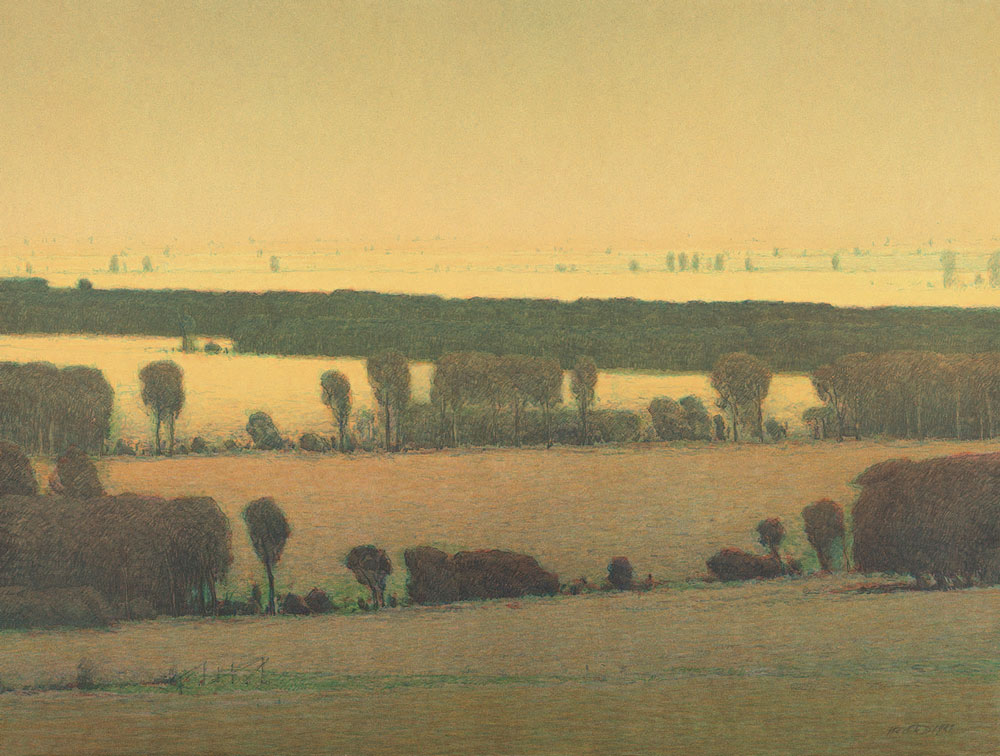
Cowboys & Indians: Much of your work has been tied to the rugged landscapes of south central Montana before your return to Northern California’s Marin County, where you grew up and began painting. From a landscape artist’s perspective, could these two Wests be any more different?
Russell Chatham: They probably couldn’t be much more different from anyone’s perspective. Although I’d say that they do share certain intrinsically Western qualities, which would be the solitude, wildness, beauty, and utter timelessness you can still find in both places — I mean, depending on where exactly you’re standing.
C&I: Where exactly are you standing?
Chatham: Right now I’m in my painting studio in Inverness Park, California. I live about 15 miles up the road in Marshall, population 50, but you’d have to turn over a lot of rocks to come up with those 50 people. The ranch I live on is thousands and thousands of wilderness acres, and there probably aren’t 25 people residing on it. And my drive to work along the edge of Tomales Bay is pretty much the commute from heaven. On a weekday morning, I usually don’t pass a single car.
Marin County, of course, has those other connotations nowadays — like being super-uptight, posh, and crazy-expensive. But where I’m based, it’s real wilderness. Just one big ranch on top of the next, run by a handful of old ranching families who still hunt deer. So you could say it has that in common with Montana. It’s still out there.
C&I: Was this a formative landscape for you as a young artist? The timeless terrain of the other Marin?
Chatham: Absolutely. As well as the Carmel Valley down in Monterey County where a lot of Swiss-Italian immigrant families, including my mother’s family, bought land in the 1850s for practically nothing. I spent a lot of summers down there as a kid with my brother and two sisters, and it was about as simple and remote as it gets. No TV, no electricity, no nothing. We had a choice: Go play in the creek or go paint.
C&I: Or go paint the creek.
Chatham: [Laughs.] I often opted for both.
C&I: Was your famous grandfather [landscape painter Gottardo Piazzoni] an influence in your early painting pursuits?
Chatham: He was a very great painter, but I was only 5 when he died, so my actual time with him was limited to early memories — though I did get to see him paint. I remember my mother taking me to his studio in downtown San Francisco and watching him up on the scaffolds working on some new murals for the San Francisco Library.
After he was gone, his paintings were all over the house, so in a sense he was still there, and his work was certainly an influence for me — especially once I was old enough to travel to New York and Europe to see the great art of the Western world. It made my grandfather’s paintings even more meaningful because I realized that they could hold up against all of that.
C&I: Ironic that you had to go east to fully appreciate great paintings of the West.
Chatham: Well, you know, the West was a fairly primitive place from an artist’s standpoint back then, if you want to know the truth. I mean, the only real center for it was San Francisco, along with some artistic activity happening in the L.A. area. When I was a younger artist, this whole area was still a frontier that way. I remember being told that if I wanted to be an artist, I’d need to move to New York. And I said, “Well, then I guess I’m not gonna be an artist, because I’m not moving to New York.”
C&I: You became an artist and moved to Montana instead. An unconventional decision with its own rationale?
Chatham: A very practical decision in its own way. It was 1971; I was 31 years old; I saw the crowds coming to California, and things starting to get very expensive where I was. And, I thought, I can’t hold down two $1.50-an-hour jobs in Marin and try to paint on Saturday. That’s just not going to work. I’m never going to learn.
Fortuitously, my friend [writer] Thomas McGuane had gone to Montana, called me up, and said, “C’mon and go fishing with me and hang out.” I went there and just immediately thought, This is it. All the space, beauty, wide-open landscape, and hunting and fishing I could ever want. Here was this place called Livingston, Montana, where I could rent an entire 600-acre ranch back then for $500 a year. So that worked.
C&I: Montana is a giant canvas for a young, self-taught landscape painter. Was it a challenging transition?
Chatham: When I first went to Montana I was baffled. I remember thinking, I really don’t know if I can paint this at all. I knew I had to, but it took years to figure out an approach to its sheer size and physicality — and also to what I could paint out there that made sense to me and felt real. I mean, it wasn’t going to be the Old Man of the Mountain or Sunset in the Rockies. There weren’t any of those rolling hills and sensual sedimentary settings I was used to in California. Everything was spiky and enormous. There were all sorts of new technical factors in that environment to deal with.
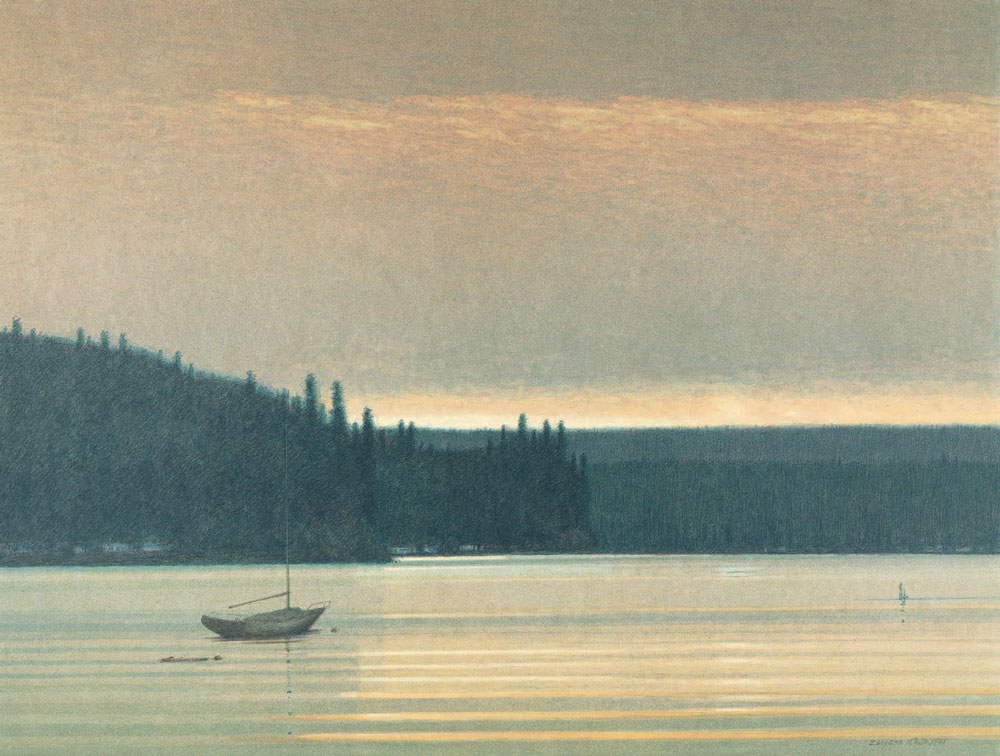
C&I: Including seasonal ones. Like real winter.
Chatham: That was a big one. For a while it was all about making hay between late spring and early fall, because who’s going out sketching when it’s 25 below? But at a certain point, I knew I had to deal with winter, because that’s what it is a lot of the time out there. Nine months of winter and three months of bad skiing.
It’s also a very colorless season there. Everything’s black or white. So that was a challenge too — finding a bloom of color hiding in the Montana winter. And I think I found it. I began to develop a whole oeuvre of work that dealt strictly with winter. I also really mined the area where I was based [Deep Creek, near Livingston] to find and utilize closer spaces that felt more intimate.
C&I: Was that its own epiphany in Big Sky Country? Go small, or at least smaller?
Chatham: Well, it was for me. Everything is so rugged, huge, and distant out there, and it can be very difficult otherwise to create a setting that resonates on a personal level — where you can bring the viewer into the painting as if opening up a window that they can enter.
C&I: How would you describe the relationship between your painted landscapes and the real ones that inspire them? It’s been said that your paintings exist “somewhere between impression and illusion.” Fair assessment?
Chatham: I think that’s pretty fair. On the one hand, these landscapes are a tool to engage visual imagination. But on the other, I want to create a real sense of attachment to them — to shoot for an experience that people can access. I don’t want to befuddle, confuse, or insult anyone. And I think there’s a whole aspect of contemporary art — and there has been for at least a hundred years — of expressing contempt for the bourgeois patron. Well, why? What are you gaining by that? It’s ridiculous.
C&I: Is there a Western sensibility at work here, too, to tap into a favorite C&I theme? An effort to give it straight without any airs?
Chatham: Yeah, I think so. I really do. The more urban a society becomes, the more intense and affected the human element can get because there’s so many people and so much noise in every sense. That’s one of the things I most appreciate about being in the West and painting Western landscapes. Out here, you can get away from the influence of all that very easily and quickly. Far easier, I think, than in most other places.
It’s funny though — to get back to the “reality” question. I can’t tell you how many times somebody will look at one of my paintings and say, “Oh, that’s fantastic. I know right where you stood when you made that.” Well, no you don’t, because I made it out of my head. But the goal is to trick you into thinking that you stood there.
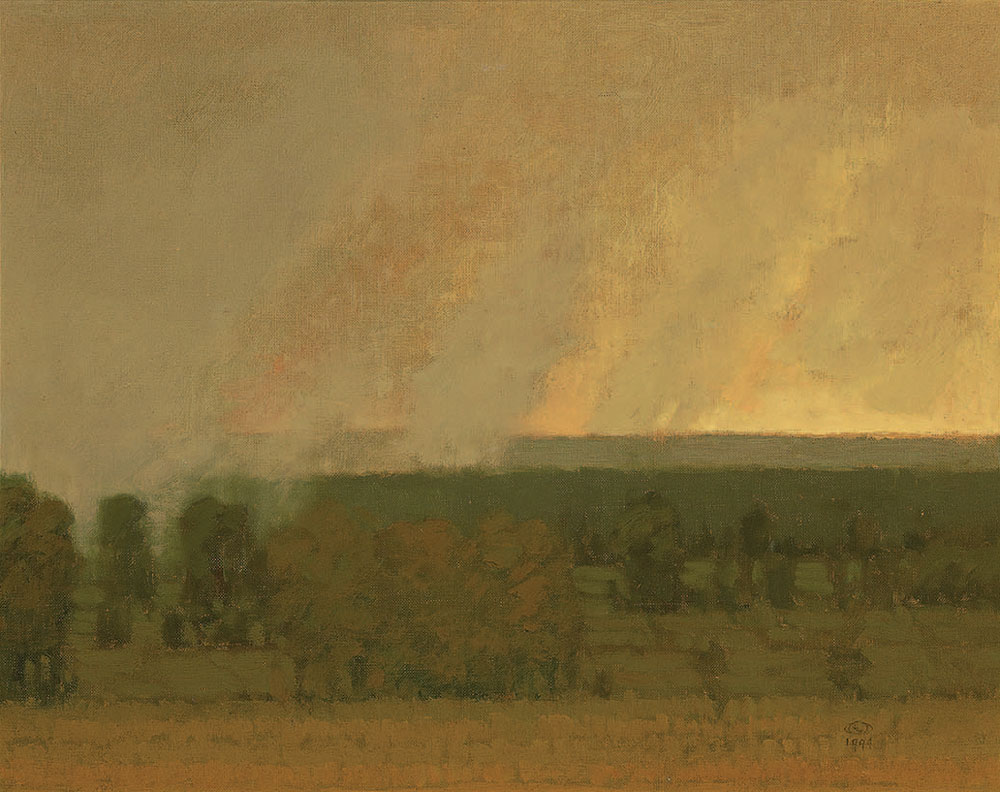
C&I: How do you find or choose your landscapes? Or do they choose you? Does it always begin with a walk through that giant canvas?
Chatham: It always starts with some on-site experience. It doesn’t necessarily have to be a walk. It could be when I’m driving home — and I look over and I see the sun doing something with some clouds over there, and I just know that I’ve either got to find a place to pull over or turn around and go back, get out the sketchbook and do something fast that imprints the image before it’s lost.
C&I: Do you ever take photos?
Chatham: Occasionally, but you really have to be careful with that because the camera reduces the experience to two dimensions, and as an artist you don’t see in two dimensions — you see in three and four. The temptation with a photograph is to copy it, and that’s the worst thing you can do. It quashes your visual imagination, unlike a simple pencil drawing, which for me is a tool to engage it.
C&I: Your lithographs are every bit as sought-after as your oil paintings — famously labor-intensive, too. Do you see a return to lithography at any point?
Chatham: It’s possible, though at the moment it’s just not the practical thing for me to be doing. Although I’ve probably done more lithography than anybody who ever lived. In fact, I’m absolutely certain of it.
C&I: You’ve described your elaborate lithographic process as “coaxing something warm, sensual, and alive out of 10,000 pounds of gears, ratchets, and switches.” What fostered your interest in creating art this way?
Chatham: It just started out as this idea that I wasn’t even sure I could pull off — and also as a way to establish a market where there were multiple originals that could help with my living. But if that was all there was to it, I never would’ve stuck with it. I ended up doing so much of it that it became artistically fascinating to me and I think I was able to take it to a realm of color which no one has ever done. However, I started out as a painter, and even though I can also dream in lithography now and may go back to it at some point, painting still comes first.
C&I: Has your return to California felt like an artistic homecoming of sorts — but from a different era?
Chatham: Totally. And I can kind of trick myself into feeling like it’s still the same era because the landscape itself where I am hasn’t changed. It’s changed everywhere else, almost, but not so much in Point Reyes or up in the neighboring ranch country. To me, it looks just like it did 50 years ago, which is a blessing for a landscape artist. Wherever you are as a painter, I think it’s the familiarity that creates the depth of whatever paintings you do.
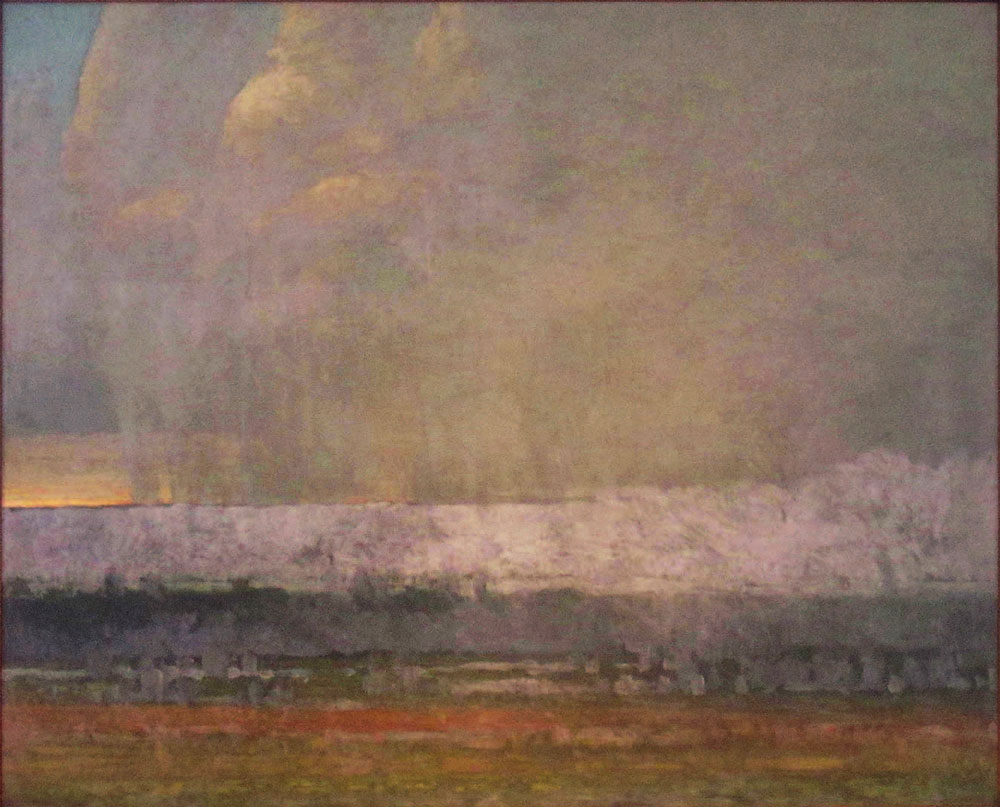
C&I: So much of your work is in private collectors’ hands. Where’s the best place to go hunting for a Russell Chatham work these days — aside from the bookstore, where they grace many a Jim Harrison paperback cover?
Chatham: I have a long relationship with John Broschofsky in Sun Valley [Broschofsky Galleries, Ketchum, Idaho], who I think has at least 10 of my paintings, which is a lot. The Suttons Bay Galleries out of Michigan is a good place for my lithographs especially. If somebody really wants a painting, they could always send me an inquiry [P.O. Box 877, Marshall, California 94940] and we can talk if they’re serious. I don’t get a lot of tire-kickers [laughs] and I’m not knocking ’em out.
C&I: A word about all those Jim Harrison book covers. How does one go about painting an image to encapsulate a Jim Harrison novel?
Chatham: You don’t. All those paintings on his book covers weren’t painted for the books. With one exception — Dalva, where it had to have a portrait of Dalva on the cover. I actually held up production on that book for a year because it took me that long to find the right person to model the title character after — a young woman managing a hunting camp in Mexico. But the rest of those book covers were just arbitrarily selected.
C&I: By him?
Chatham: No. By me.
C&I: Did you read the book first?
Chatham: No. Rarely. I used to sometimes, and then I thought, This is silly. I’m just going to end up randomly picking a painting anyway.
C&I: You and the late author were great friends and shared a huge love for the outdoors. Any lasting memory of him you’d like to share with an audience of Harrison fans?
Chatham: There are too many of them over a friendship that lasted nearly 50 years. A big part of our time together was spent bird hunting in the Upper Peninsula [Michigan] in the ’70s and ’80s. And, believe me, if you’re gonna spend that kind of time with someone in the field, you’re gonna know who the hell they are when you’re done. He was as big and curious a personality as people reading his books would imagine. His brain was just too big — that’s the way I look at it. You rarely had a quiet moment with Jim. He loved to talk. About everything.
C&I: You’ve done your own share of writing. Including about fishing, which is a second passion for you.
Chatham: Or first, depending on the time of year.
C&I: Any favorite landscapes to escape to with the rod when you put down the brush?
Chatham: It used to be my backyard out here on the California coast, but a lot of those fish are relegated to history. So now it’s Canada, Alaska. I’m going to Iceland this summer. Places like that. Which are distant and expensive, but that’s where we haven’t wrecked it yet.
C&I: Back to the brush. What do you want people to ultimately take from your paintings, including for the few who can take pride in owning one?
Chatham: Excitement. A rush or an energy that comes from something I’ve put my heart into without false motive or artifice. When art is working, there’s a certain pure joy that’s conveyed. Along with a feeling of play — the sense that what the artist was doing when he created this was having a helluva good time. I think people are naturally attracted to that energy, often without really even knowing it, but that’s what’s making it work for them.
When it comes down to it, that’s pretty much what it’s always really about, right? Something that’s just felt.
From the January 2018 issue.



